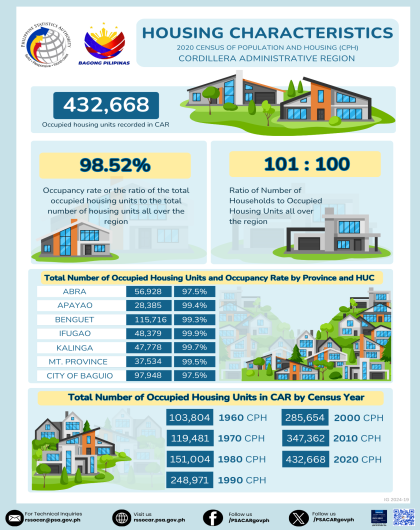Total population up by 105 thousand persons
- As of 1 August 2015, the Cordillera Administrative Region had a total population of 1,722,006 persons based on the 2015 Census of Population (POPCEN 2015).
-
The total population based on the POPCEN 2015 is higher by 105,139 persons compared with the 2010 Census of Population and Housing (CPH) count of 1,616,867 persons.
Figure 1. Total Population, CAR: 1990 – 2015
Population increases by 12 persons per year for every 1,000 persons
-
The increase in the Cordillera’s population translated into an average population growth rate (PGR) of 1.2 percent annually during the period 2010 to 2015. This means that there were about 12 persons added per year for every 1,000 persons in the region.
-
The 2010-2015 annual PGR was lower compared to 1.7 percent during the period 2000 to 2010 and at 2.3 percent during the period 1990 to 2000.
Table 1. Annual Growth Rates, CAR by Province/HUC: 2000, 2010 and 2015
A quarter of the total population resides in Benguet
-
The Province of Benguet comprised a quarter (25.97 percent) of the region’s total population. It was followed by Baguio City (20.06 percent), and Abra (14.00 percent).
-
Among the 6 province and Highly Urbanized City (HUC) of the region, Apayao had the least population with total count of 119,184. Apayao is considered as one of the least populated municipalities in the Philippines.
Figure 2. Total Population By Province/HUC
Males outnumber females
- Of the total population, 51.06 percent was male while 48.94 percent was female. This was translated to a sex ratio of 104 males for every 100 females. The same sex ratio was reported in 2010 and 2000.
-
The province of Apayao posted the highest sex ratio of 109 males for every 100 females. Only Baguio City recorded more females than males, that is, 94 males for every 100 females. Generally, there were more males than females across census years.
Table 2. Sex Ratio by Province/HUC, CAR: 2000, 2010 and 2015
Median age is 24.1 years
- In 2015, the median age of the country’s total population was 24.1 years, which means that half of the total population was below 24.1 years old. Median age was highest in Abra (25.9 years) and lowest in Kalinga (23.1 years).
Average household size in 2015 is 4.33 persons
- As of August 2015, the household population in CAR reached 1.71 million (1,714,220), higher by 103 thousand compared with household population of 1.61 million (1,611,669) in 2010, and by 354 thousand compared with household population of 1.36 million (1,360,611) in 2000.
-
The number of households, meanwhile, increased by 12.34 percent from 352,403 in 2010 to 395,881 in 2015.
-
The average household size in 2015 was 4.33 persons, lower than the average household size of 4.57 persons in 2010.
Table 3. Household Population, Number of Households and Average Household Size
CAR: 2015
Dependency ratio is 57 dependents per 100 persons in the working-age group
-
Of the total population, 63.79 percent belonged to the working-age population (15 to 64 years). Children below 15 years of age comprised 31.16 percent while older persons (65 years and over) accounted for 5.05 percent.
-
The overall dependency ratio of Cordillera in 2015 was 57 dependents for every 100 persons in the working age group. Of the 57 dependents, 49 were young dependents while eight were old dependents.
Table 4. Dependency Ratio, CAR: 2015
School attendance rate is higher among females than among males
- Of the 707,539 household population aged 5 to 24 years, 516,101 persons or 72.94 percent was attending school in School Year (SY) 2015-2016.
-
The school attendance rate in 2015 was higher among females (50.11 percent) than among males (49. 89 percent). The same trend was observed in 2010.
Table 5. School Attendance Rate, CAR: 2015
Simple literacy rate is 97.8 percent
-
The region posted a literacy rate of 97.77 percent among the 1,354,180 household population aged 10 years and over. This is higher than the 96.08 percent literacy rate that was recorded in 2010. A person is considered literate if he/she is able to read and write a simple message in any language or dialect.
-
Literacy rate in 2015 was slightly higher among males (98.11 percent) than among females (97.42 percent). Similarly, literacy rate was slightly higher among males (96.39 percent) than among males (95.76 percent) in 2010.
Table 6. Literacy Rate, CAR: 2015
Technical Notes


